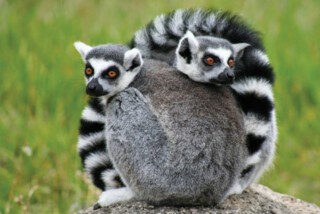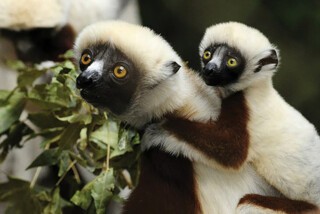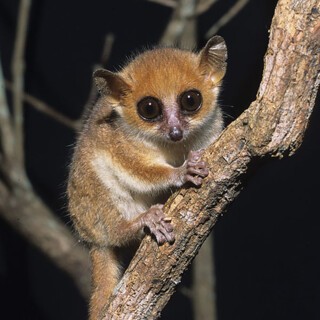It is probably best not to take advice direct and unfiltered from the animal kingdom – but lemurs are, I think, an exception. They live in matriarchal troops, with an alpha female at their head. When ring-tailed lemurs are cold or frightened, or when they want to bond, they group together in a furry mass known as a lemur ball, forming a black and white sphere that ranges in size from a football to a bicycle wheel. They intertwine their tails and paws, and press against one another’s walnut-sized swiftly beating hearts. To see it feels like an injunction of sorts: to find a lemur ball of one’s own.
The first lemur I ever met was a female, and she tried to bite me, which was fair, because I was trying to touch her, and humans have done nothing to recommend themselves to lemurs. She was an indri lemur, living in a wildlife sanctuary outside Antananarivo; she had an infant, which was riding not on her front, like a baby monkey, but on her back, like a miniature Lester Piggott. She had wide yellow eyes. William Burroughs, in his lemur-centric eco-surrealist novella Ghost of Chance, described the eyes of a lemur as ‘changing colour with shifts of the light: obsidian, emerald, ruby, opal, amethyst, diamond’. The stare of this indri resembled that of a young man at a nightclub who urgently wishes to tell you about his belief system, but her fur was the softest thing I have ever touched. I was a child, and the indri, which is the largest extant species of lemur, came up to my ribs when standing on her hind legs. She looked, as lemurs do, like a cross between a monkey, a cat, a rat and a human.
Lemurs are strange in the way that the reclusive and the wealthy are strange; having had an island to themselves to evolve in, they have idiosyncratic habits. Male ring-tailed lemurs have scent glands on their wrists, and engage in ‘stink-fighting’, battles in which they stand two feet apart and wipe their hands on their tails, then shake the tail at their opponent, all the while maintaining an aggressive stare until one or other animal retreats. It feels no madder than most current forms of diplomacy. It’s not unusual for female ring-tailed lemurs to slap males across the face when they become aggressive.
There are at least 101 species and subspecies of lemurs in Madagascar; there were once lemurs the size of small men, but after humans arrived on the island two thousand years ago the larger lemurs were hunted to extinction. At the smallest end of the scale is the Madame Berthe’s mouse lemur, the smallest primate in the world, which weighs thirty grams on average and at full stretch couldn’t cover your hand. Somewhere in the middle is the northern giant mouse lemur, whose testes comprise 5.5 per cent of its body mass; the equivalent proportions in a man would be testicles the size of grapefruits. They are strange, then, and beautiful, and occasionally disconcerting.
The indri lemur was right to try to bite me; more right than she knew. The early human arrivals on the island eradicated at least 15 species of lemur. Now, largely due to deforestation, 24 species are critically endangered, 49 are endangered and 94 per cent of all species are threatened. Until recently there was a strong taboo on hunting lemurs. Rural traditions held eating lemur flesh to be second in horror only to human flesh; some stories told that the lemurs were human ancestors who had become lost in the Madagascan rainforest and changed themselves into lemurs to survive. Other stories told of a man who, falling to certain death from a high tree, was caught by an indri lemur, and set upright on the ground. The taboo was first eroded through poverty and desperation: in rural households where lemur was eaten the children were almost invariably found to be malnourished. As is often the case, the swiftest route to animal conservation would be to prioritise child health.
So the myths have not saved the lemurs. And when we endow anything or anyone with mystic powers we usually end by killing it. The aye-aye lemur is thought in some areas to be able to prophesy death; they have vast eyes, large, sensitive ears, and a middle finger that’s twice as long as their other digits; when the aye-aye points its middle finger at a person they are taken to be cursed. Another story tells that it uses the long finger to puncture human hearts. As a result they’re unbeloved, and hunted so relentlessly they were thought to be extinct until they were rediscovered in 1961. The word lemur comes from the Latin lemures, meaning ‘ghost’. It is terrifyingly possible that several subspecies may become exactly that.
Perhaps the most astonishing fact about lemurs is that they survived at all. Madagascar was part of Gondwanaland until 180 million years ago, when the supercontinent began to split and the island began to drift eastwards from Africa. But the first lemur-like fossils date from between 62 and 65 million years ago, and appear in mainland Africa. How, then, did the lemurs reach Madagascar? There are many theories – island-hopping and land bridges among them – but the dominant theory is that the lemurs drifted there on floating rafts of vegetation. The island, too, kept drifting, so when monkeys evolved enough to eradicate lemurs on the mainland with their superior adaptiveness and aggression, somewhere between 17 and 23 million years ago, Madagascar was safely out of reach. I have seen many things that I’ve loved, but I don’t think I’ll live to see anything as fine as a raft of lemurs, sailing across the sea towards what looked, until the arrival of humans, like safety.
Send Letters To:
The Editor
London Review of Books,
28 Little Russell Street
London, WC1A 2HN
letters@lrb.co.uk
Please include name, address, and a telephone number.




